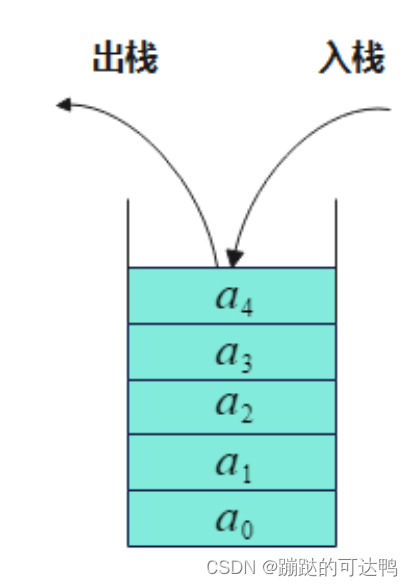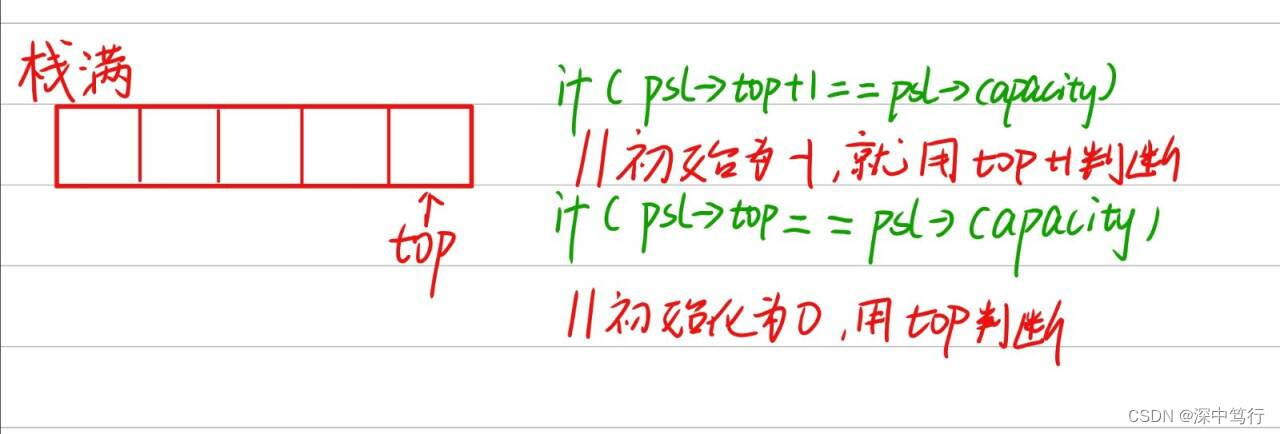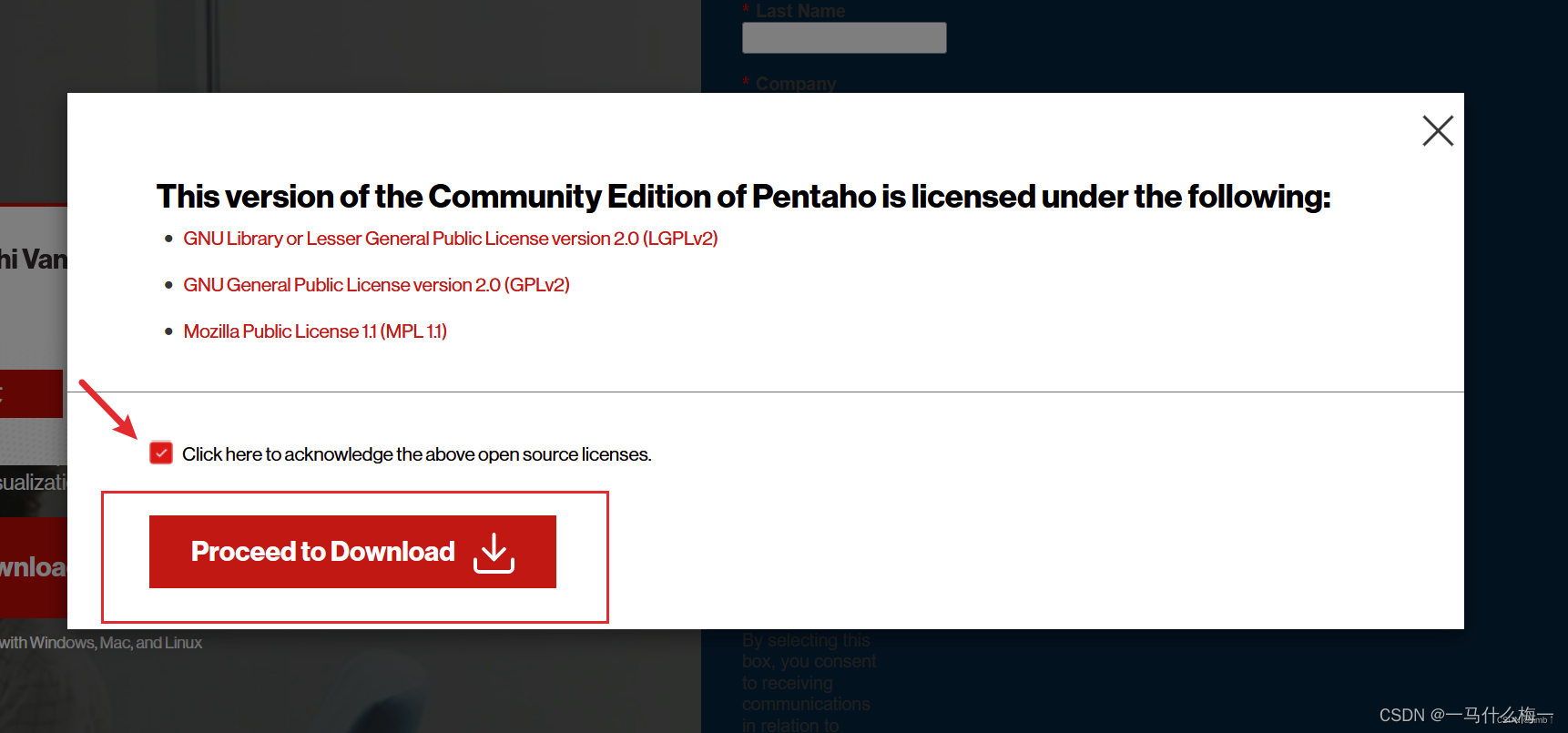栈
首先宏观上是在干什么?
概念
栈:⼀种特殊的线性表,其只允许在固定的⼀端进⾏插⼊和删除元素操作。进⾏数据插⼊和删除操作 的⼀端称为栈顶,另⼀端称为栈底。栈中的数据元素遵守后进先出LIFO(Last In First Out)的原则。
压栈:栈的插⼊操作叫做进栈/压栈/⼊栈,⼊数据在栈顶。
出栈:栈的删除操作叫做出栈。出数据也在栈顶。

栈底层结构选型
核心原则:后来者居上
其次有哪些假设?
栈的实现可以用哪个数据结构实现?
栈的实现⼀般可以使⽤数组或者链表实现,相对⽽⾔数组的结构实现更优⼀些。因为数组在尾上插⼊ 数据的代价⽐较⼩。

栈的实现
入栈

代码如下:
// ⼊栈
void STPush(ST* ps, STDataType x)
{
assert(ps);
//1.判断空间是否足够
if (ps->capacity == ps->top)
{
int newCapacity = ps->capacity == 0 ? 4 : 2 * ps->capacity;
STDataType* tmp = (STDataType*)realloc(ps->arr, newCapacity * sizeof(STDataType));
if (tmp == NULL)
{
perror("realloc fail!");
exit(1);
}
ps->arr = tmp;
ps->capacity = newCapacity;
}
//空间足够
ps->arr[ps->top++] = x;
}
和写顺序表进行插入数据的操作非常的相似
出栈

如果栈为空,不可以出数据,所以要先判断栈是否为空
代码如下:
/判断栈是否为空
bool StackEmpty(ST* ps)
{
assert(ps);
return ps->top == 0;
}
根据栈的性质,我们可以返回栈顶的方式来判断
//出栈
void STPop(ST* ps)
{
assert(ps);
assert(!StackEmpty(ps));
--ps->top;
}
代码如下:
Stack.h
#pragma once
#include <stdio.h>
#include <stdlib.h>
#include<assert.h>
#include<stdbool.h>
//定义栈的结构
typedef int STDataType;
typedef struct Stack
{
STDataType* arr;
int capacity;//栈的空间大小
int top;//栈顶
}ST;
// 初始化栈
void STInit(ST* ps);
// 销毁栈
void STDestroy(ST* ps);
//栈顶--入数据 出数据
// ⼊栈
void STPush(ST* ps, STDataType x);
//出栈
void STPop(ST* ps);
//判断栈是否为空
bool StackEmpty(ST* ps);
//获取栈中有效元素个数
int STSize(ST* ps);
Stack.c
#define _CRT_SECURE_NO_WARNINGS 1
#include "Stack.h"
// 初始化栈
void STInit(ST* ps) {
assert(ps);
ps->arr = NULL;
ps->capacity = ps->top = 0;
}
// 销毁栈
void STDestroy(ST* ps)
{
assert(ps);
if (ps->arr)
free(ps->arr);
ps->arr = NULL;
ps->capacity = ps->top = 0;
}
// ⼊栈
void STPush(ST* ps, STDataType x)
{
assert(ps);
//1.判断空间是否足够
if (ps->capacity == ps->top)
{
int newCapacity = ps->capacity == 0 ? 4 : 2 * ps->capacity;
STDataType* tmp = (STDataType*)realloc(ps->arr, newCapacity * sizeof(STDataType));
if (tmp == NULL)
{
perror("realloc fail!");
exit(1);
}
ps->arr = tmp;
ps->capacity = newCapacity;
}
//空间足够
ps->arr[ps->top++] = x;
}
//判断栈是否为空
bool StackEmpty(ST* ps)
{
assert(ps);
return ps->top == 0;
}
//出栈
void STPop(ST* ps)
{
assert(ps);
assert(!StackEmpty(ps));
--ps->top;
}
//获取栈中有效元素个数
int STSize(ST* ps)
{
assert(ps);
return ps->top;
}
Test.c
#define _CRT_SECURE_NO_WARNINGS 1
#include "stack.h"
void STTest()
{
ST st;
STInit(&st);
STDestroy(&st);
STPush(&st, 1);
STPush(&st, 2);
STPush(&st, 3);
STPush(&st, 4);
printf("size:%d\n", STSize(&st));
//循环出栈,直至栈为空
while (!StackEmpty(&st))
{
STDataType data = StackTop(&st);
printf("%d", data);
//出栈
StackPop(&st);
}
}
int main()
{
STTest();
return 0;
}
栈这个概念和我们之前学的概念有什么区别?
栈里面的数据不能被遍历,也不能被随机访问,这是和顺序表,链表不同的地方
有关栈的一道算法题
有效的括号
给定一个只包括 '(',')','{','}','[',']' 的字符串 s ,判断字符串是否有效。
有效字符串需满足:
- 左括号必须用相同类型的右括号闭合。
- 左括号必须以正确的顺序闭合。
- 每个右括号都有一个对应的相同类型的左括号。
示例 1:
输入:s = "()"
输出:true
示例 2:
输入:s = "()[]{}"
输出:true
示例 3:
输入:s = "(]"
输出:false
提示:
1 <= s.length <= 104s仅由括号'()[]{}'组成
思路:
借助数据结构中的栈来解决
先定义ps ,ps是{[()]}
若ps遍历到的符号是左括号,入栈,若ps遍历到的字符为右括号,取栈顶元素,与ps进行比较,栈顶元素匹配*ps,出栈,ps++;
栈顶元素不匹配*ps,返回false
代码如下:









































